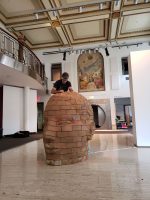“Brick by Brick: The Erie Canal and the Building Boom” Exhibit to Open Sept. 30

From its beginnings in the seventeenth century with New York’s early Dutch settlers, the story of brick-making in the Hudson Valley is a truly American story, rich with complex and challenging intersections of immigration, industry and innovation of family enterprise, the environment and economic development.
ArtsWestchester has explored this and more as part of its upcoming exhibition “Brick by Brick: The Erie Canal and the Building Boom,” which opens Sept. 30.
Supported by a $75,000 grant from the New York State Council on the Arts (NYSCA), the exhibition will feature large-scale installations presented alongside historical materials, archival and commissioned photographs and personal narratives related to the region’s once vital brick industry.
An opening reception will be held on opening day from 4 to 6 p.m. (RSVP requested to LHaney@ArtsWestchester.com). The exhibit will be on view at ArtsWestchester’s gallery space at 31 Mamaroneck Ave., White Plains from Oct. 2, 2018 to Jan 19, 2019.
“The humble brick has been the driving force behind the building boom that flourished in the 19th Century from the Erie Canal to New York City,” said Janet T. Langsam, CEO of ArtsWestchester. “While the state’s brick industry faded after World War II, its presence is ubiquitous in our towns and cities, in sidewalks, buildings, homes of all sizes, public works and factories. Our exhibition will celebrate the brick industry’s rich history while giving it new life in contemporary art forms.”
Hudson Valley bricks are both the subject and the material for the artists in the exhibition. Artworks range from large-scale contemplative human heads constructed from brick to commissioned photographs of remnants of the industry to paintings and glass sculptures that interpret brick’s aesthetic qualities.
The $75,000 state grant, awarded as part of Governor Andrew M. Cuomo’s Regional Economic Development Council Initiative, enabled ArtsWestchester to commission original artwork by area artists including: Julia Whitney Barnes (Poughkeepsie), Liene Bosquê (New York), Ori Carino & Ben Armas (New York), Lynda Shenkman (Pleasantville), Susan Cox (Katonah), Tom Fruin (Brooklyn), Jacqueline Meier (Mamaroneck), Christopher Payne (New York), Jean Marc Superville Sovak (Beacon/Newburgh), James Tyler (Haverstraw), Adam Welch (New Jersey).
“Positioned alongside historic materials and the colorful personal accounts of brick-industry descendants and enthusiasts, the artworks are a compelling introduction to the history and functionality of brick,” explains Kathleen Reckling, ArtsWestchester Gallery Director. “For the artists in the exhibition, bricks become eloquent symbols for a range of subjects: of the transient quality of the manmade, of the fragility of our environment, of forgotten histories and of shared human experiences.”
Photographer Christopher Payne is renowned for documenting the remnants of American industry. For “Brick by Brick,” Payne was commissioned to photograph the brickyards’ legacy, including such significant sites as the Old Croton Aqueduct and the ruins of the castle on Bannerman Island. Sprawling along the Hudson River’s shores are “brick beaches,” sites where over-cooked and misshapen bricks were dumped and forgotten. Payne has captured these sites, while artists like Julia Whitney Barnes, James Tyler, and Jean Marc Superville Sovak source their materials from the beaches.
Julia Whitney Barnes, whose public art installations use hundreds of historic bricks to form a scale version of the Hudson River from New York City to Albany, said, “Though our past has spawned many building technologies, our most enduring structures were crafted from brick and stone. Living in Brooklyn, it was an almost daily event that I saw brick edifices demolished, disassembled into piles that were gathered and carted off to points unknown. I started collecting bricks from destroyed buildings and defunct brickyards. Of the estimated 400 brickyards along the Hudson, I currently have approximately 165 brickyards (and hundreds of bricks) represented in my collection.”
Liene Bosquê, whose large, white, brick-like hexagonal structure includes impressions taken of the exterior of the Erie Canal Museum in Syracuse, said, “I’m interested in materials that hold a memory and are also already saturated with meaning. I investigate the passage of time, which changes place and how we look at place, through the presence and absence of who inhabit these places.”
Adam Welch’s work incorporates design, documentation and intervention to investigate history and material culture. He said, “I find limitless and liberating potential in the fixed structure of the brick. My interest stems from it being a thing in itself, existing as universal, ironical and is ever-present.”
ArtsWestchester Director of Folk Arts Aaron Paige reminds us, “Hudson Valley brick is all around us. It lies within our homes and businesses, speckles our forests, covers our shorelines, and appears in our stories and dreams. This exhibition connects the materiality of brick as historic and aesthetic object to the intangible stories that local residents construct around it. The adventures of brick hunters, the discoveries of collectors, as well as the tales and songs of ancestors past, all find voice here.”
The exhibit is accompanied by two programs at the ArtsWestchester gallery: Songs of the Brickyards – The Untold Story of the Haverstraw African-American Experience, Nov. 11, 3 p.m. and Bricklore and Swap date and time to be announced at artsw.org/brickbybrick.

